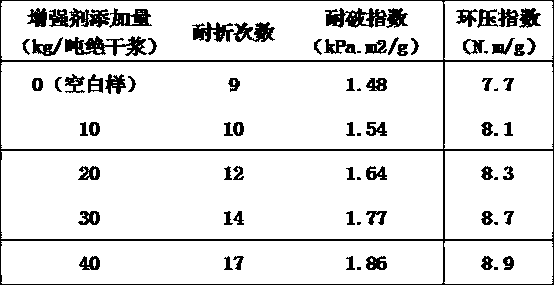A cationic polymer graft modified nanocrystalline cellulose and its preparation method and application
A cationic polymer and nano-crystallization technology, which is applied in the direction of reinforcing agent addition, can solve the problems of increased white water concentration and ineffective adsorption of polymers, so as to improve physical strength, improve retention rate and system retention rate, and improve paper machine The effect of speed
- Summary
- Abstract
- Description
- Claims
- Application Information
AI Technical Summary
Problems solved by technology
Method used
Image
Examples
specific Embodiment 1
Appropriate amount
[0033] The preparation method comprises the following steps:
[0034] Add 900 g of soft water to a 2000 ml four-neck flask equipped with a turbine stirrer, RTD temperature sensor, reflux condenser and nitrogen inlet tube, add 225 g of nanocrystalline cellulose at a stirring speed of 120 RPM, and stir while stirring. Raise the temperature to 50°C, wait until it is completely dissolved, pass nitrogen gas and raise the temperature to 90°C, add 1.5 g of ethylenediaminetetraacetic acid (EDTA), 15 g of phosphoric acid, and 15 g of sodium hydroxide.
[0035] After stirring evenly, first add 5% ammonium persulfate aqueous solution at a constant flow rate (4 ml / min), and after 3 minutes, start adding acrylamide (50%) and dimethyldiallyl dropwise at a constant flow rate (10.8 ml / min) ammonium chloride (65%) monomer mixture, after 60 minutes of dripping, use 5% ammonium persulfate aqueous solution for 8 minutes.
[0036] Then keep warm at 85°C-105°C and react ...
specific Embodiment 2
Appropriate amount
[0038] The preparation method comprises the following steps:
[0039] Add 855 g of soft water to a 2000 ml four-neck flask equipped with a turbine stirrer, RTD temperature sensor, reflux condenser and nitrogen inlet tube, add 300 g of nanocrystalline cellulose at a stirring speed of 120 RPM, and stir while stirring. Raise the temperature to 50°C, wait until the solution is completely dissolved, blow nitrogen gas and raise the temperature to 90°C, add 1.5 g of EDTA-2Na, 15 g of phosphoric acid, and 15 g of sodium hydroxide.
[0040] After stirring evenly, first add 5% ammonium persulfate aqueous solution at a constant flow rate (4 ml / min). After 3 minutes, start to add N,N-dimethylacrylamide (50%) dropwise at a constant flow rate (9.8 ml / min). And dimethyl diallyl ammonium chloride (65%) monomer mixture solution, after 60 minutes of dripping, 5% ammonium persulfate aqueous solution for 8 minutes.
[0041] Then keep warm at 85°C-105°C and react for 1-...
specific Embodiment 3
[0042] The acrylamide in specific embodiment 1 is replaced by one selected from acrylamide, N,N-dimethylacrylamide, N,N-diethylacrylamide, N-vinylformamide, acrylonitrile A variety of nonionic monomers; the replacement of dimethyl diallyl ammonium chloride in specific embodiment 1 is the methyl chloride selected from dimethyl diallyl ammonium chloride, dimethylaminoethyl acrylate Quaternary ammonium salt, methyl chloride quaternary ammonium salt of dimethylaminoethyl methacrylate, methyl chloride quaternary ammonium salt of diethylaminoethyl methacrylate, methyl chloride quaternary ammonium salt of diethylaminoethyl methacrylate Ammonium salt, dimethylaminopropyl acrylamide methyl chloride quaternary ammonium, dimethylaminopropyl methacrylamide methyl chloride quaternary ammonium, dimethylaminoethyl acrylate benzyl chloride quaternary, Benzyl chloride quaternary ammonium salt of dimethylaminoethyl methacrylate, benzyl chloride quaternary ammonium salt of diethylaminoethyl meth...
PUM
| Property | Measurement | Unit |
|---|---|---|
| length | aaaaa | aaaaa |
| diameter | aaaaa | aaaaa |
| molecular weight | aaaaa | aaaaa |
Abstract
Description
Claims
Application Information
 Login to View More
Login to View More - R&D
- Intellectual Property
- Life Sciences
- Materials
- Tech Scout
- Unparalleled Data Quality
- Higher Quality Content
- 60% Fewer Hallucinations
Browse by: Latest US Patents, China's latest patents, Technical Efficacy Thesaurus, Application Domain, Technology Topic, Popular Technical Reports.
© 2025 PatSnap. All rights reserved.Legal|Privacy policy|Modern Slavery Act Transparency Statement|Sitemap|About US| Contact US: help@patsnap.com


